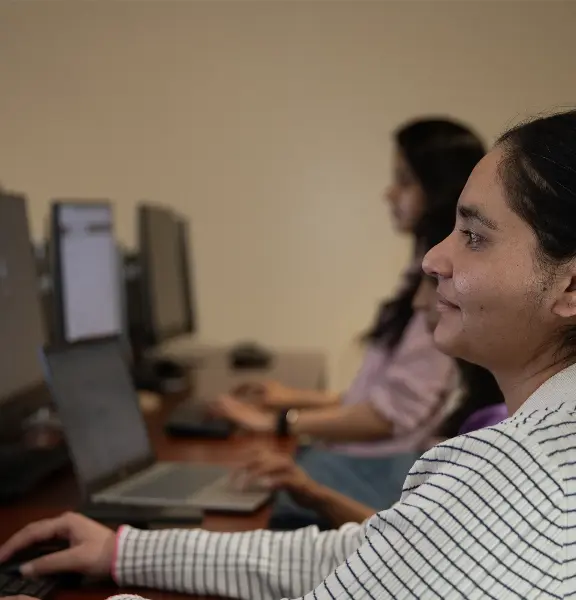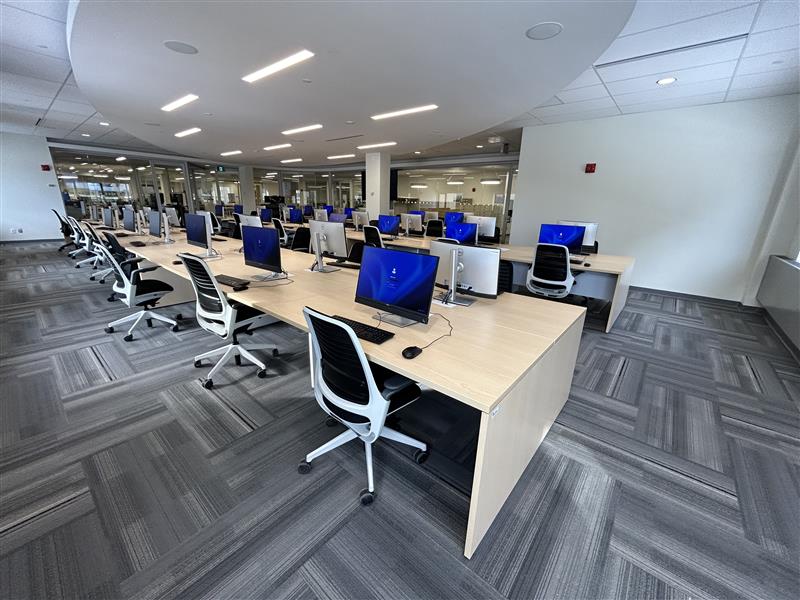

Full Stack Software Development
CIP Code: 11.0201
Overview
Are you someone who likes to see the full picture? As a full stack web developer you will have a comprehensive understanding of the entire web development process, and the ability to create and implement complete solutions from start to finish.
The Full Stack Software Development program is an Ontario College Graduate Certificate that offers students the opportunity to study the most current trends in software development. This intensive, two-year program concludes with a work term for eligible students.
Software development includes three tiers - user interface, business logic, and database. Full Stack Software Developers have experience in front-end web development that includes the user interface (UI) for browsers and mobile devices and back-end development that includes developing software containing the business logic that accesses databases. Simply, full stack developers have an understanding of the presentation tier, business logic tier, and data tier of software development.
Front-end languages and technologies include HTML5, CSS5, JavaScript, jQuery, Bootstrap, React and others to develop user interfaces. The business logic uses server-side programming languages and frameworks such as Java, C# .NET, Python, Node.js and others. The database layer includes SQL and NoSQL, and MongoDB. Additionally, DevOps tools such as Git, GitHub, Integrated Development Environments (IDEs), and Continuous Integration and Continuous Delivery (CI/CD) pipelines are essential to build and release high quality software in a time efficient manner.
Students demonstrate their knowledge and skills by developing solutions to real world three-tier (client, server, and database) problems. Major term projects are assigned that span entire terms allowing students to actively engage in the evaluation, design, and implementation of real-world software applications. As a result, students develop deep content knowledge as well as critical thinking, collaboration, creativity, and communication skills.
The widespread use of computer technology in all industries, from manufacturing, transportation, construction, education, health and financial institutions means that full stack developers are the key people shaping the solutions of today and tomorrow. Graduates use their problem solving and critical thinking skills to analyze business and industry requirements and design, develop and implement real-life, database driven, enterprise web applications.
Ottawa - A Great Place to Study
Immerse yourself in the rich and vibrant culture of Canada's capital city.
Enjoy the beautiful city on the banks of the Ottawa River, live affordably, and let us help you succeed in your future aspirations.
Admission Requirements
- University degree in the information technology field
The admissions process is competitive and meeting the minimum academic requirements does not guarantee admission.
Lambton College reserves the right to alter information including admission requirements and to cancel a program or course at any time; to change the program curriculum as necessary to meet current competencies or changes in the job market; to change the pathways to third-party certification bodies; or to withdraw an offer of admission both prior to and after its acceptance by an applicant or student because of insufficient applications or registrations or over-acceptance of offers of admission. In the event Lambton College exercises such a right, Lambton College's sole liability will be the return of monies paid by the applicant or student to Lambton College.English Language Requirements
Applicants must submit proof of English proficiency through one of the following in-person test methods:
- IELTS Academic: Overall score of 6.0
- TOEFL IBT: Overall score of 70
- PTE Academic: Overall score of 53
- CAEL: Overall score of 60
- CELPIP: CLB 7
- Lambton Institute of English Placement Test: Overall score of 70
- Completion of an English pathway program at a recognized partner school
Meeting the minimum English requirements does not guarantee admission. Students with higher English proficiency scores will receive priority in the admission assessment process. Not all students will qualify for EAP-3106 in place of the required IELTS or TOEFL test scores.
Costs
- Term 1 $9,476.72
- Term 2 $8,615.19
- Term 3 $9,315.19
- Co-op Term $0.00
Total Cost of Program
Tuition fees are estimates and are subject to change each academic year. Fees do not include books (unless specifically noted), supplies or living costs.
Lambton College reserves the right to alter information including admission requirements and to cancel at any time a program or course; to change the location and/or term in which a program or course is offered; to change the program curriculum as necessary to meet current competencies or changes in the job market; to change the pathways third-party certification bodies; or to withdraw an offer of admission both prior to and after its acceptance by an applicant or student because of insufficient applications or registrations or over-acceptance of offers of admission. In the event Lambton College exercises such a right, Lambton College’s sole liability will be the return of monies paid by the applicant or student to Lambton College.
Additional Fees
WIL Project Fees
Students who are not successful in securing a co-op or fail to meet the co-op requirements will need to register in CPL-5559 WIL Project.
There is an additional fee of $2,100 for each student enrolled in the WIL Project course.
Textbooks
The anticipated cost for textbooks in this program is approximately $500 - $700 per term. This amount accounts for both mandatory textbook costs (included in tuition fees) as well as textbook fees not included in your tuition fee amount.
Important Dates, Deadline & Late Fees
For additional information on registration dates, deadlines and late fees please refer to Registration Dates and Deadlines.
Student Fees
A student services fee is included in your tuition.
Health Insurance Coverage
Emergency medical insurance is mandatory for all international students at Lambton College. This includes students who are full-time and part-time and who are on a co-op. This insurance is provided by GuardMe - a third party insurance provider.
See Insurance Costs & DetailsTechnology Requirements
In order to keep pace with the requirements of each and every course in your program, Lambton College requires that each student have access to a laptop while studying at our college.
Computer Labs
Courses
Front-End Web Development I
Through a blend of theoretical concepts and practical applications, students master the creation of dynamic and engaging websites. Using a hands-on approach, students integrate modern web technologies to (1) design and implement well-structured and semantically meaningful web pages using HTML; (2) implement Cascading Style Sheets (CSS) to enhance the visual appeal of web pages, including techniques for layout, formatting, and responsive design; (3) incorporate JavaScript that adds interactivity, dynamic content, and functionality to web pages; and (4) design and publish a comprehensive and fully functional website.
Problem Solving & Problem Logic
Programming logic and problem solving - without them, software development skills are learned but soon forgotten. A language-independent approach introduces students to various components common to all programming languages without assuming any previous programming experience. Students (1) design, test, and debug programs using a top-down modernized approach; (2) control the flow of a program with decision and repetitive structures and functions; (3) implement array processing; and (4) develop programs that process data from files including control break processing. Students develop software solutions using pseudocode and flowchart software tools with an emphasis on problem solving and structured programming techniques.
Python Programming
This course uses the Python programming language to reinforced programming logic and problem solving skills taught in CSD 1133, Problem Solving/Program Logic. Students implement Python programs to (1) design, test, and debug programs using a top-down modernized approach; (2) control the flow of a program with decision and repetitive structures and functions; (3) implement array processing; and (4) develop programs that process data from files including control break processing.
Relational Database Design
A comprehensive introduction to relational database design and implementation, emphasizing theoretical concepts and practical applications. Using a hands-on approach, students (1) analyze user requirements and develop data models using Entity-Relationship Diagrams (ERD), normalization techniques, and relational data modeling principles; (2) create and modify database table structures using SQL Data Definition Language (DDL); (3) create test data and use SQL Data Manipulation Language (DML) to insert, update, delete, and query data; (4) implement and test database constraints to ensure data integrity; and (5) design and implement a comprehensive database system aligned with typical business requirements, concluding with detailed technical documentation.
Introduction to Project Management
Project management has become essential to the operations of modern organizations. This course will allow students to gain the fundamental knowledge in managing IT projects and learn to solve real-world problems using both predictive and adaptive approaches, industry best practices, cutting-edge tools, and software. Students will prepare for the Project Management Institute (PMI) exams to achieve a Certified Associate in Project Management (CAPM) certification, setting a strong foundation for a career in Project Management.
Networking Fundamentals
The practical aspects of design, implementation, installation, documentation and maintenance of Local Area Networks (LANs) and Wide Area Networks (WANs) are introduced. Students (1) implement network topologies; (2) distinguish and manage network protocols and services; (3) implement network security components; and (4) implement, configure, maintain and troubleshoot a variety of network equipment including switches, routers and access points.
Job Search & Success
This course provides student with skills and knowledge to help support their career search and succeed in the workplace. Students align their personal skill set and goals to guide them on their career paths. They will learn how to effectively conduct a job search, build a professional and well-tailored resume and cover letter, and develop and practice interview techniques. Students will also develop their personal brand to help support effective career networking and aid in their job search. Teamwork and collaboration in the workplace are also discussed. Self-reflection is used to inspire insight and support their professional career journey.
Front-End Development II
This course is a continuation of CSD 1103, Front-End Web Development I, where JavaScript and jQuery are introduced. Students (1) implement JavaScript and jQuery to enhance the user experience; (2) implement various components of JavaScript including the Document Object Model, form validation, and object-oriented programming; (3) employ AJAX to allow server-side requests to exchange data with a web server; and (4) manage events using jQuery.
Programming C# .NET
The C# programming language is introduced. Students (1) create, test, and debug programs using a top-down modernized approach; (2) implement decision and repetitive structures and functions to control program flow; (3) formulate object-oriented designs using classes, instance variables and methods and constructors; (4) evaluate, create and analyze objects including strings and arrays. Microsoft Visual Studio is used for program development.
Programming Java SE
Various components of the Java object-oriented programming language are introduced. Students (1) develop solutions using data types, I/O, control structures, methods and objects; (2) work with arrays, reference types, inheritance, polymorphism, packages, GUI applications and recursion; and (3) document solutions with javadoc comments.
Relational Database & SQL
Building upon CSD 2203, students expand their skills in relational database design and Structured Query Language (SQL). Using a hands-on approach, students (1) use Barker's notation to broaden knowledge in database design and implementation; (2) create queries for single-table and multi-table databases, leveraging advanced join operations and conditional logic; (3) employ subqueries, Common Table Expressions (CTEs), and advanced filtering for more complex data retrieval; and (4) implement database views and indexes to streamline data access and optimize database performance.
Python II
This course is a continuation of Python programming. Students (1) develop applications using Object-Oriented Python; (2) access databases with Python; and (3) use Python libraries and frameworks.
Data Structure & Algorithms
This course is designed to provide a comprehensive introduction to data structure and algorithms, with an emphasis on both theoretical concepts and practical implementations. Students will learn about essential data structures such as linked lists, stacks, queues, and trees, as well as fundamental algorithmic approaches for sorting, searching, and problem-solving. Additionally, the course covers key design patterns within the creational, structural, and behavioural categories, which are critical for effective software design.
Full Stack JavaScript
As a continuation of Web Technologies II, students design and implement component-based web applications using JavaScript and JavaScript frameworks. This course introduces students to the MERN (MongoDB, Express, React, Node) web stack. Students (1) develop software using modern JavaScript standards (ES6+); (2) develop web applications that maintain a NoSQL database; (3) implement applications adhering to the microservice architectural pattern by developing web API endpoints, and (4) develop applications that run on a variety of computing platforms. Students add to their term project in Web Technologies II by designing and implementing component-based applications that include client-side, server-side, and database processing.
Web Applications Using C# .NET
The C# programming language is expanded upon and ASP.NET is introduced. Students (1) implement web applications that follow the MVC architecture pattern by leveraging the ASP.NET MVC framework; (2) build web applications that interface with databases through the use of Entity Framework; (3) manage project dependencies with NuGet package manager; and (4) test applications with unit tests.
Programming Java EE
As a continuation of Programming Java SE, students (1) manage databases using Java; (2) build two- and three-tier client-server applications; and (3) refine industry-standard coding practices. Students build a complete Web-based application that incorporates three-tier development including client-side, server-side, and database processing.
DevOps: Tools & Practices
Modern software development is done with a high degree of velocity, often with software changes being released multiple times daily or weekly. This course introduces students to industry-standard tools and techniques that help manage the development and release of such software using Agile methodologies and DevOps principles. Students (1) evaluate technical and business background details related to DevOps;(2) evaluate Cloud platforms as a deployment option for applications; (3) evaluate responsibilities of operations teams and get familiar with their day-to-day operations;(4) evaluate CI/CD pipelines and their components and discuss micro-service architecture;(5) evaluate containers and containerization as the most up-to-date application delivery method. Throughout the term, students work in teams on a term project, to develop and deploy software with evolving requirements. Students will document these changes based on Software Requirement Specification standards.
Cloud Computing
Traditionally, software applications were deployed on physical servers owned and maintained by the organization developing the software; however, over the past decade, there has been a shift from companies of all sizes towards leveraging cloud computing platforms over in-house servers due to a variety of economic and technical reasons. In this course students will (1) evaluate technical and fundamentals topics of cloud computing, (2) analyze various methods for cloud management, (3) evaluate cloud platform solutions including infrastructure as a service (IaaS) to install and configure virtual resources on the cloud platforms, (4) evaluate storage provisioning, networking, testing and deploying cloud technologies, (5) discuss cloud computing standards, security, the business in cloud computing and methods of planning for cloud integration, and last but not least, (6) discuss cloud deployment options and cloud DevOps.
Database Programming
A comprehensive journey into SQL and PL/SQL database programming within the dynamic Oracle database environment. Using a hands-on approach, students (1) create robust PL/SQL blocks that incorporate program control structures, embedded SQL statements, powerful cursors for data manipulation, and exception handling routines; (2) leverage the power of stored procedures and functions to design efficient, reusable code that scales easily in database development; (3) create packages that encapsulate and organize related PL/SQL objects, fostering modularity, scalability, and maintainability in database projects; (4) create database triggers that automate database actions and enforce data integrity constraints, ensuring database reliability and consistency. This course, combined with added study materials, prepares students for the Oracle PL/SQL certification exam.
Work Term (Full-Time)
Co-operative education provides students with the opportunity to apply classroom learning to the workplace, undertake career sampling and gain valuable work experience that may assist students in leveraging employment after graduation.
WIL Project
Work Integrated Learning (WIL) Project is aimed at enriching students by connecting different program areas of study, cutting across subject-matter lines, and emphasizing unifying concepts. The focus of the WIL Project is to make connections between study and industry by engaging students in relevant and meaningful activities that are connected to and practiced within the professional workplace. WIL Project allows students to enhance and strengthen their employability prospects post-graduation by fine tuning skills and knowledge and meeting the expectations of today's employers. Students are required to attend the scheduled shifts in the WIL office, reporting to the WIL Supervisor. Weekly real-world challenges are presented in the WIL office, designed by industry professionals. In addition to the weekly assigned deliverables, students are also offered professional development sessions, and exposed to industry guest speakers, enhancing their opportunity to develop their professional network.
Co-op Eligibility & WIL Project Fee
In order to be eligible to secure an approved full-time co-op work term (CPL-1049), students must have a GPA of 2.8 or greater and complete all the co-op eligibility requirements. Failing to do so will require students to enroll in CPL-5559 WIL Project at an additional cost.
Contact
Centre for Global Engagement
LAMBTON COLLEGE SARNIA
1457 London Road
Sarnia ON N7S 6K4
After Graduation
Employment Opportunities

Graduates may expect a wide variety of rewarding career opportunities that are dynamic and challenging while offering a competitive rate of compensation.
A wide variety of rewarding career opportunities that are dynamic and challenging, offering a competitive rate of compensation are available to graduates. Courses prepare graduates for careers as computer programmers, software developers, web developers, programmer analysts, application developers, systems analyst, information system specialist, client/server applications developers, systems programmers, and application support analysts.
Graduates acquire sufficient foundation to allow them to advance in a variety of career paths appropriate to their interests and abilities.
Looking for Support After Graduation?
The International Graduate Services & Support Centre (GSSC) is a place dedicated to assisting International alumni as they seek employment and settle into Canadian life following graduation.
Post-Graduate Employment
International students who successfully complete their programs of study at Lambton College may be eligible to apply for a Post-Graduation Work Permit (PGWP) Program. This program allows students to gain valuable Canadian work experience.
A work permit under the PGWP may be issued for the length of the study program, up to a maximum of three years. A post-graduation work permit cannot be valid for longer than the student's study program, and the study program must be a minimum of eight months in length. The length and approval of the PGWP is determined solely by Immigration, Refugees and Citizenship Canada (IRCC).
Students must meet the eligibility requirements to apply for a post-graduation work permit.
Immigration Regulations & Changes
Immigration regulations are legislated by the Federal Government of Canada and are subject to change at any time without notice. Students are responsible for ensuring that they are in compliance with all Immigration, Refugees and Citizenship Canada regulations at all times during their studies and while in Canada. Lambton College staff are not authorized to provide advice or guidance on immigration-related matters. Prospective applicants and current students should consult the Immigration, Refugees and Citizenship Canada website or call the IRCC Call Centre at 1-888-242-2100 to answer or clarify any immigration-related questions or information.
Co-op
About Co-op
Students in this program have the opportunity to gain valuable work experience by applying classroom learning during co-op experiences.
Learn more about co-op terms and the roles and responsibilities of students and co-op advisors.
More Information
Student Responsibilities
- Course and program delivery schedules are proposed and subject to change for each intake.
- Students are required to bring their own laptop with wireless capability.
- Students are advised to bring an official copy of their most recent police clearance, driver's license, and vaccination record from their home country.

Transferring to Sarnia Campus
Students can transfer to the main campus in Sarnia before or during the first 10 days of any term, dependent on course and seat availability.
Special permission from the Dean, International Education must be granted after receiving a written request by email listing the following:
- Student's Name
- Lambton ID
- Reason for requesting the transfer
Transfers during a co-op term are not permitted.
Technology Requirements
It is recommended that students purchase a laptop with a Windows operating system.
Internet Speed Requirements
For best performance for students learning remotely, an internet connection with a minimum of 40 Mbps download and 10 Mbps upload speed is recommended in order to effectively use video conferencing and remote lecture delivery software as well as, other online resources remotely. Due to the large area over which students may be dispersed, we are unable to recommend a specific provider, so you will need to inquire around your area to find one that best suits your needs.
Minimum Laptop Requirements
In order to access the internet and virtually-delivered software and courseware, student laptops should include the following at a minimum. By meeting the following specifications, students will be equipped to access software and courseware on their laptop through the internet:
- Intel i5 8th Gen Processor or equivalent
- 16 GB of RAM (with a minimum of 8 GB)
- 100 GB HDD or more
- HD Graphics
- Webcam with a microphone
- Wireless 802.11n/ac 5ghz capable
- Windows Operating System (Windows 11)
Please note that Chromebooks and MacBooks may not support all software required for your program; students should verify compatibility with their professors.
Software
To ensure students are getting the most our of their classroom experience, some software will be required.
Lambton College has made this software easily accessible online. Students can leverage our Microsoft Office 365 software packages and services. In addition, much of the software you require for your courses will be available on demand for use on any device - on or off campus.




